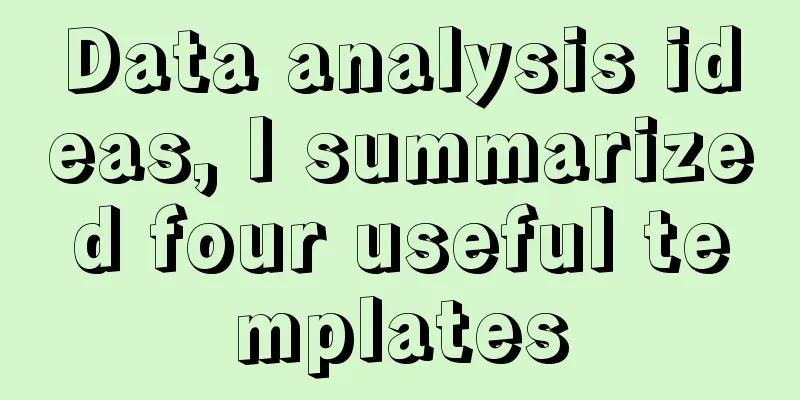Data analysis ideas, I summarized four useful templates

As the saying goes, "a scholar forgets the words when he picks up a pen." When the leader asks students to "analyze XXX," their brains buzz and they lose their ideas. Today, I will share 4 simple and easy-to-use ideas that can deal with most problems. Everyone, prepare your notebooks and start right away. Idea 1: Declarative analysisApplicable questions: "Please analyze the sales/operations/products/membership/logistics situation" Applicable scenarios: Leadership/business has no clear requirements, and business data is viewed for the first time The key point at this time is to explain the situation clearly. Clarity is the first requirement. So don't be impatient and don't dump too much data at once. If people can't understand it, they will blame you for "the analysis is not clear." At this time, you can start in the following way: "Current situation → Goal → Overall progress → Sub-department progress". For example, if you want to analyze the user situation, you can make the following introduction (as shown below): If the overall progress is not a big problem and each sub-department is progressing smoothly, then everyone will not express too many opinions and will say "very good, continue to monitor" after reading it. If there is a problem with the overall progress, then everyone's thinking will be guided to: "Why is department A executing well, but department B is not?" Go up, so that further analysis can be done. It should be noted that different people have different “first times”. The most classic scenario is that you have reviewed the data in your own department many times, but now you have to make a report to the senior management, who usually do not know your details at all. At this time, you must not be too anxious. If you pile up a lot of data and make the senior management dizzy, you will most likely be criticized for "not having clear ideas". It will be better to stay calm and make a declarative analysis. Idea 2: Exploratory analysisApplicable questions: "Recent sales/operation/product/membership/logistics indicators have not met the standards. Why?" Applicable scenarios: Leadership/business has clear problems, but no specific suspects The key point at this time is to guide everyone's thinking and implement it on a specific object that can be improved. This is very important! When facing a problem, many students like to describe the current situation over and over again. For example, when asked "Why do users spend less?" he would answer naively: "Because the average order value is low." This is nonsense. Consumption = number of users * consumption rate * average order value. If the average order value is low, consumption will definitely be low. The question is why is the average order value low? Is it because of the poor quality of the product? Is it because of too many promotions? This is what everyone cares about. Therefore, when doing exploratory analysis, the problem should be broken down into specific things that a certain department is responsible for, so that a solution can be implemented. For example, if "recent user consumption has not met the standard", you can do the following exploration (as shown below): Idea 3: Test analysisApplicable question: "Is there any connection between the recent decline in our membership spending and the adjustment of our preferential policies?" Applicable scenario: The leader/business has made a clear analysis request and expects a response The key point at this point is to exclude other possibilities and focus on the core issue. Everyone should pay attention that many times it sounds like there is only one hypothesis, but in fact the scope of investigation is more than that. But when you say: "It is confirmed that it is the impact of policy adjustments", it means that you have chosen "not an implementation problem, nor an external problem." If other obvious problems are not ruled out, nine out of ten times you will be criticized as: "The analysis is not comprehensive, can you do what I say?" At this time, you need to actively collect: What other business assumptions are there? Some factors that everyone has agreed on and do not need to be considered can be excluded from the analysis, and focus on a few core issues. The most common assumption is: Is it a strategy problem or an execution problem? For example, "Is there any relationship between the decline in member consumption and the normal discount?" can be broken down into: Hypothesis 1: Due to the adjustment of discounts, some members are dissatisfied and stop spending. Assumption 2: The preferential policy is fine, but the publicity is insufficient and many members are still not aware of it. Another common assumption is that it is a problem in one's own department or a problem in a neighboring department. For example, "Is there any relationship between the decline in member consumption and the normal discount?" can be broken down into: Hypothesis 1: Due to the adjustment of discounts, some members are dissatisfied and stop spending. Assumption 2: The discount policy is fine, but the products of this season are not good, so no matter how much discount there is, it will be useless. At this point, the data analyst's work skills are really tested. Because it is very likely that your leader wants to shift the blame to others (or to prevent others from shifting the blame), so collecting evidence is very important. Which of the two hypotheses is more valid depends entirely on how many positive/negative examples are collected. The more senior the data analyst, the more capable he is of collecting sufficient evidence to prove that his leader's idea is correct! ! Idea 4: Test-based analysisApplicable question: "If we adjust the policy/change the product/improve the layout, will it solve the problem?" Applicable scenario: The leader/business mentioned something that has not yet happened and is planned to be done At this point, three key questions need to be clarified: Should testing be done at all? What level of testing should be done? What exactly should be tested?
In summary, experimental suggestions are provided based on the type of project. In addition, before the experiment, be sure to record the following information clearly so that you can do the analysis:
For example, if you want to optimize the delivery effect, you'd better record it clearly: whether this version changes the promotion main image, keywords, site path or products/discounts, so that you can compare between versions. If you change too much at one time, you can only look at the overall effect and cannot get into details (as shown in the figure below). From the above, we can see from the whole process that the key is to maintain close communication with the business and understand business needs and prescribe the right medicine. Author: Down-to-earth Teacher Chen, WeChat public account: Down-to-earth Teacher Chen. |
<<: Only by having the courage to try and make mistakes can you make money!
>>: Why can’t you learn from Luckin’s private domain? A private domain director’s soulful reflection
Recommend
Want to win the battle for overseas traffic? Don’t miss these festivals in December this year!
This article starts from overseas history and cult...
How to check the sales volume of Amazon store? What are the methods?
As an Amazon merchant, you must pay attention to y...
What is the traffic password of Xiaomi copywriting?
What is the secret of Xiaomi's successful car ...
How to write a personal evaluation
How to write a personal evaluation? How to optimiz...
20 yuan for five years of all network resources, crazy piracy makes the film and television industry cry
This article details the impact of current pirated...
Can I leave a review on Amazon without purchasing the product? How can I leave a review without getting rejected?
Because Amazon reviews can affect product rankings...
How to implement the no-source model in cross-border e-commerce? How to do cross-border e-commerce well?
With the continuous development of cross-border e-...
July Marketing Strategy | How can brands seize the user's mind and take advantage of it accurately?
Editor's note: July is coming, and within 30 d...
Can shein sell the same product? How does shein list products?
Shein is loved by consumers for its rich variety o...
100 Keyword Predictions for 2023 | Health (81-90): Gua Sha, Meta-Mindfulness, and “Rest” Exercises
WPP's brand Wunderman Intelligence released it...
How to highlight brand personality and gain more fans?
To some extent, we can understand "brand pers...
Roasted cactus, roasted watermelon...all kinds of weird barbecues are popping up, and netizens are calling for help!
The "weird trend" in Chengdu's barbe...
What is the difference between THC charges and terminal charges? What are the ocean freight surcharges?
When friends open a store on a cross-border e-comm...
Video accounts have changed: Who makes money? Who gets hurt?
As a live e-commerce platform embedded in WeChat, ...
How to register on Facebook? How to use it in China?
In today's highly developed and popular social...









